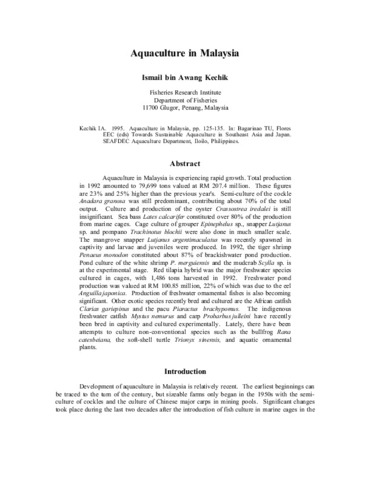Optimization of culture conditions for tissue culture production of young plantlets of carrageenophyte Kappaphycus
| dc.contributor.author | Yunque, Dianne Aster T. | |
| dc.contributor.author | Tibubos, Keneth R. | |
| dc.contributor.author | Hurtado, Anicia Q. | |
| dc.contributor.author | Critchley, Alan T. | |
| dc.date.accessioned | 2013-11-13T07:13:23Z | |
| dc.date.available | 2013-11-13T07:13:23Z | |
| dc.date.issued | 2011 | |
| dc.identifier.citation | Yunque, D. A. T., Tibubos, K. R., Hurtado, A. Q., & Critchley, A. T. (2011). Optimization of culture conditions for tissue culture production of young plantlets of carrageenophyte Kappaphycus. Journal of Applied Phycology, 23(3), 433-438. | en |
| dc.identifier.issn | 0921-8971 | |
| dc.identifier.uri | http://hdl.handle.net/10862/1725 | |
| dc.description.abstract | To improve the production of Kappaphycus plantlets in tissue culture, optimum media concentrations of an Ascophyllum nodosum extract (Acadian Marine Plant Extract Powder, AMPEP), plant growth regulators (PGR), pH–temperature combinations, and explant density were determined. Kappaphycus alvarezii var. tambalang purple (PUR), kapilaran brown (KAP), vanguard brown (VAN), adik-adik (AA), tungawan green (TGR), and K. striatum var. sacol green (GS) were used as explants. Based on the shortest period for shoot emergence and the economical use of AMPEP, the optimum enriched media was 3.0 mg L−1 AMPEP and 0.1 mg L−1 AMPEP + PGR 1 mg L−1 each phenylacetic acid (PAA) and zeatin for PUR, 1.0 mg L−1 AMPEP + PGR for KAP and GS, 0.1 mg L−1 AMPEP + PGR for VAN, and 3.0 mg L−1 AMPEP and 0.001 mg L−1 AMPEP + PGR for AA and TGR. Results showed that the addition of PGR to low concentrations of AMPEP hastened shoot formation. pH–temperature combinations for the most rapid shoot formation were determined for the brown (KAP) and purple (PUR) color morphotypes of K. alvarezii var. tambalang and the green morphotype of K. striatum var. sacol (GS) cultured in 1.0 mg L−1 AMPEP + PGR. The brown morphotype produced the most number of shoots at pH 7.7 at 20°C after as little as 20 days. Purple K. alvarezii showed an increased shoot formation at pH 6.7 at 25°C and the green K. striatum morphotype at pH 8.7 at 25°C. The optimum number of explants added to the culture media was also determined for tungawan green (TGR), brown (KAP), and tambalang purple (PUR) varieties of K. alvarezii in 1.0 mg L−1 AMPEP + PGR. The number of explants and the volume of the culture media combination were also tested. The highest average number of shoots formed occurred in two explants:1 mL culture media (2:1) for KAP and PUR (35.00% and 16.67%, respectively) and 1 explant: 2 mL culture media for the TGR (100.00%) with a range of 0.5–3.0 mm shoot length after 40 days in culture. The earliest shoot formation was observed after 21 days for the brown and 9 days for both the green and purple color morphotypes of Kappaphycus, in all densities investigated. This indicated that within the range tested, the density of explants did not have a significant effect on the rate of shoot formation but did influence the average number generated from the culture. The rate of production of new and improved Kappaphycus explants for a commercial nursery stock was improved through the use of AMPEP with optimized culture media pH, temperature, and density conditions. | en |
| dc.language.iso | en | en |
| dc.publisher | Springer Verlag | en |
| dc.subject | Ascophyllum nodosum | en |
| dc.subject | Kappaphycus alvarezii | en |
| dc.title | Optimization of culture conditions for tissue culture production of young plantlets of carrageenophyte Kappaphycus | en |
| dc.type | Article | en |
| dc.identifier.doi | 10.1007/s10811-010-9594-7 | |
| dc.citation.volume | 23 | |
| dc.citation.issue | 3 | |
| dc.citation.spage | 433 | |
| dc.citation.epage | 438 | |
| dc.citation.journalTitle | Journal of Applied Phycology | en |
| seafdecaqd.library.callnumber | VF SJ 0862 | |
| seafdecaqd.databank.controlnumber | 2011- | |
| dc.subject.asfa | culture media | en |
| dc.subject.asfa | mariculture | en |
| dc.subject.asfa | nursery grounds | en |
| dc.subject.asfa | plant growth | en |
| dc.subject.asfa | plant morphology | en |
| dc.subject.asfa | taxonomy | en |
| dc.subject.asfa | tissue culture | en |
Files in this item
| Files | Size | Format | View |
|---|---|---|---|
|
There are no files associated with this item. |
|||
This item appears in the following Collection(s)
-
Journal Articles [1256]
These papers were contributed by Department staff to various national and international journals.



